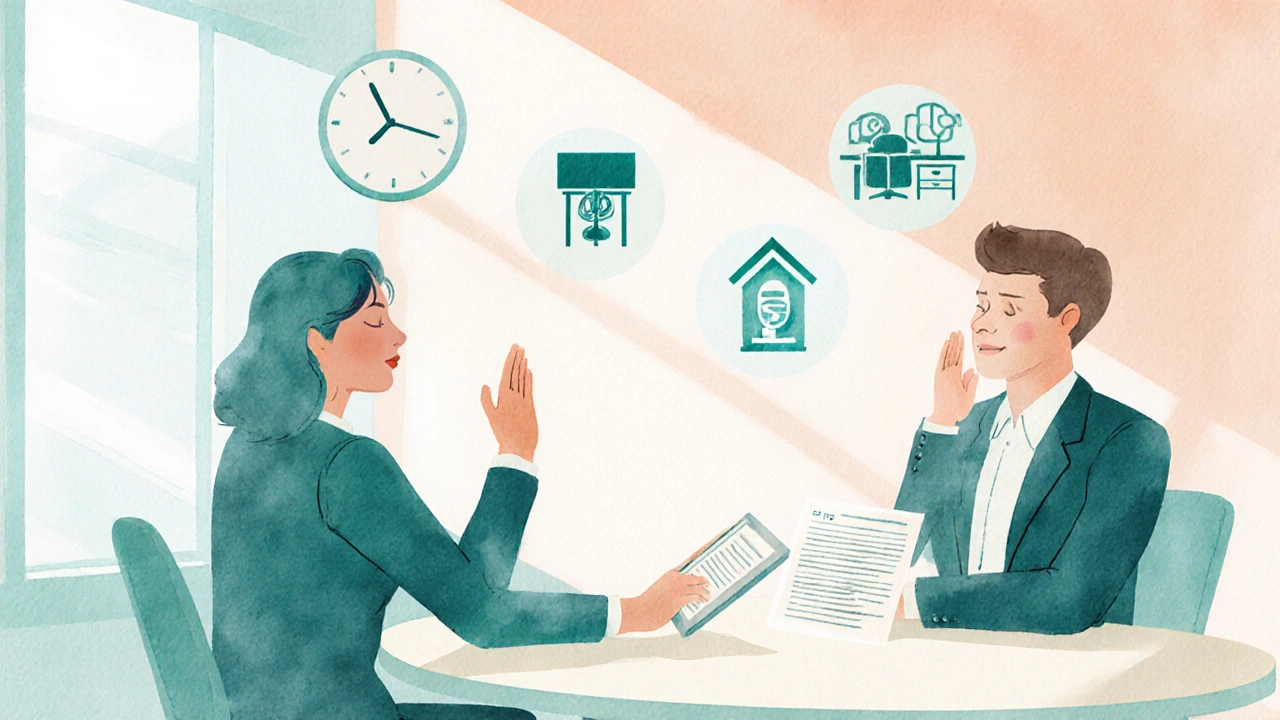Workplace Accommodation Calculator
This tool helps estimate the potential costs and productivity impacts of common workplace accommodations for endometriosis. Adjust the sliders below to see how different factors affect your accommodation choices.
Your Accommodation Impact Summary
Estimated Monthly Cost
NZ$0 - NZ$200
Based on your selections, estimated accommodation costs range from no cost to modest investment.
Productivity Impact
High - Improved focus and reduced fatigue
Adjustments such as flexible schedules and ergonomic support can significantly boost performance.
Recommended Accommodations
Living with Endometriosis is a daily balancing act, and the workplace often feels like the tightrope. Pain, fatigue, and unpredictable flare‑ups can throw a wrench into meetings, deadlines, and even a simple coffee break. The good news? With the right knowledge, a supportive employer, and some proactive habits, you can protect your health while still thriving at work.
Key Takeaways
- Know your legal rights under New Zealand’s employment and health‑and‑safety laws.
- Plan clear, compassionate conversations with your manager about needed adjustments.
- Use practical symptom‑management tools like scheduled breaks, ergonomic seating, and temperature control.
- Build a backup plan for flare‑ups, including flexible scheduling and documented medical leave.
- Create a long‑term career resilience strategy that blends self‑care with professional growth.
Understanding Endometriosis at Work
Endometriosis affects about 1 in 10 people assigned female at birth. Tissue that normally lines the uterus grows elsewhere, causing chronic pelvic pain, heavy periods, and intense fatigue. Symptoms don’t always follow the menstrual calendar; hormonal fluctuations, stress, and even diet can trigger sudden spikes.
Because the condition is invisible, coworkers may not realize why you need a quick walk to the restroom or a short rest after a meeting. That invisibility is the first hurdle to overcome.
Legal Protections in New Zealand
New Zealand law offers solid backing for employees with chronic illnesses. The Employment Relations Act 2000 requires employers to make reasonable accommodations for medical conditions, unless it creates undue hardship. Additionally, the Health and Safety at Work Act 2015 obliges workplaces to identify and manage health risks, which can include chronic pain.
If an employer refuses reasonable adjustments, you can raise a personal grievance. Document all requests, medical notes, and responses-this paper trail becomes crucial if you need to involve the Employment Relations Authority.
How to Communicate Your Needs
Effective communication starts with a clear, concise briefing. Here’s a simple three‑step script you can adapt:
- State the fact: “I have been diagnosed with endometriosis, a chronic condition that can cause unpredictable pain and fatigue.”
- Explain the impact: “On days when symptoms flare, I may need a short break every 90 minutes or a flexible start time.”
- Offer solutions: “I’ve spoken with my doctor and identified a few adjustments that work well: a sit‑stand desk, temperature‑controlled space, and the ability to work from home twice a month.”
Keep the tone collaborative-frame the request as a win‑win for productivity and well‑being.

Practical Symptom‑Management Strategies
Even with accommodations, day‑to‑day tactics make a huge difference. Below are proven habits you can start right away.
- Scheduled micro‑breaks: A 5‑minute stretch or walk every 90 minutes lowers muscle tension and improves circulation.
- Ergonomic workstation: A sit‑stand desk reduces pelvic pressure. Pair it with a lumbar pillow and an anti‑fatigue mat if you stand for long periods.
- Temperature control: Many with endometriosis feel hotter during flare‑ups. Keep a small fan at your desk or request a window seat when possible.
- Hydration and nutrition: Drinking water and limiting caffeine can lessen cramping. Pack a snack rich in magnesium (like almonds) for steady energy.
- Mind‑body tools: Deep‑breathing exercises, guided meditation, or a short yoga session can calm the nervous system and reduce pain perception.
Planning for Flare‑Ups and Medical Leave
Flare‑ups are unpredictable, so a backup plan is essential. Carry a discreet folder with:
- Doctor’s note confirming diagnosis and recommended accommodations.
- Copy of your annual leave balance and any accrued sick days.
- Contact details for HR and your manager.
When a severe flare hits, follow these steps:
- Notify your manager as soon as possible, citing your pre‑agreed protocol.
- Use paid sick leave or request a short‑term medical leave if symptoms won’t subside within a day.
- If you need to work from home, have a pre‑approved remote‑work checklist ready (stable internet, quiet space, etc.).
Remember, the law protects you from punitive action for taking legitimate medical leave.
Long‑Term Career Resilience
Endometriosis won’t disappear, but you can build a career that adapts around it. Consider these forward‑thinking moves:
- Skill diversification: Strengthen digital or project‑management skills that translate to remote or flexible roles.
- Network widely: Connect with colleagues across departments; a broad network can offer alternate project assignments during flare‑ups.
- Regular health reviews: Schedule quarterly check‑ins with your healthcare provider to adjust medication or therapy plans.
- Advocate for inclusive policies: Join employee resource groups focused on chronic illness; collective voices often shape better workplace culture.
By aligning personal health strategies with professional growth, you turn a challenge into an advantage.
Accommodation Options at a Glance
| Accommodation | Typical Cost | Impact on Productivity | Implementation Time |
|---|---|---|---|
| Sit‑stand desk | NZ$300‑$600 | High - reduces pain and improves focus | 1‑2 weeks (procurement & setup) |
| Flexible start/end times | None | Medium - aligns work hours with lower‑pain periods | Immediate (policy agreement) |
| Temperature‑controlled workspace | NZ$0‑$100 (fan or heater) | Medium - mitigates heat‑related flare‑ups | 1 week (facility request) |
| Remote work (2‑3 days/month) | Potential internet upgrade | High - allows rest between tasks | 1‑2 weeks (IT setup) |
| Extra restroom breaks | None | Low - improves comfort, modest productivity gain | Immediate (policy note) |
Frequently Asked Questions
Can I request a flexible schedule without a formal medical note?
Employers can usually accommodate flexible hours based on a simple disclosure of your condition. However, a short note from your doctor strengthens the request and speeds up approval.
What if my manager says the adjustments are too costly?
Under the Employment Relations Act, "reasonable" adjustments are required unless they cause "undue hardship." A sit‑stand desk, for example, is a low‑cost item that most employers view as reasonable.
Is endometriosis considered a disability?
If the condition substantially limits major life activities-like walking, sitting, or concentrating-it can be classified as a disability, giving you stronger legal protections.
How can I handle sudden pain during a meeting?
If you’ve arranged for micro‑breaks, simply excuse yourself for a few minutes. Keeping a discreet signal (like a small card on the table) lets others know you’ve stepped out for a health reason.
Can I claim compensation if my employer refuses accommodations?
Yes. You can file a personal grievance with the Employment Relations Authority. Successful claims may result in compensation and an order for the employer to provide the requested adjustments.

Cinder Rothschild
October 4, 2025 AT 14:35